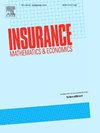二阶随机优势的新特征
IF 2.2
2区 经济学
Q2 ECONOMICS
引用次数: 0
摘要
我们为二阶随机支配(又称递增凹阶)提供了一个新的特征。这一结果有一个直观的解释,即在不利情况下增加一个预期值为负的风险,会使风险规避者对由此产生的头寸普遍不感兴趣。凸序和递增凸序也有类似的特征。主要结果的证明技术基于预期缺口的特性,预期缺口是银行和保险监管中常用的风险度量系列。本文还讨论了风险管理和保险中的应用。本文章由计算机程序翻译,如有差异,请以英文原文为准。
A new characterization of second-order stochastic dominance
We provide a new characterization of second-order stochastic dominance, also known as increasing concave order. The result has an intuitive interpretation that adding a risk with negative expected value in adverse scenarios makes the resulting position generally less desirable for risk-averse agents. A similar characterization is also found for convex order and increasing convex order. The proof techniques for the main result are based on properties of Expected Shortfall, a family of risk measures that is popular in banking and insurance regulation. Applications in risk management and insurance are discussed.
求助全文
通过发布文献求助,成功后即可免费获取论文全文。
去求助
来源期刊

Insurance Mathematics & Economics
管理科学-数学跨学科应用
CiteScore
3.40
自引率
15.80%
发文量
90
审稿时长
17.3 weeks
期刊介绍:
Insurance: Mathematics and Economics publishes leading research spanning all fields of actuarial science research. It appears six times per year and is the largest journal in actuarial science research around the world.
Insurance: Mathematics and Economics is an international academic journal that aims to strengthen the communication between individuals and groups who develop and apply research results in actuarial science. The journal feels a particular obligation to facilitate closer cooperation between those who conduct research in insurance mathematics and quantitative insurance economics, and practicing actuaries who are interested in the implementation of the results. To this purpose, Insurance: Mathematics and Economics publishes high-quality articles of broad international interest, concerned with either the theory of insurance mathematics and quantitative insurance economics or the inventive application of it, including empirical or experimental results. Articles that combine several of these aspects are particularly considered.
 求助内容:
求助内容: 应助结果提醒方式:
应助结果提醒方式:


